Abstract
Eight strains of Borrelia burgdorferi sensu lato were tested with serum samples from persons who had Lyme borreliosis or syphilis in class-specific enzyme-linked immunosorbent assays (ELISAs). Antigens of B. burgdorferi sensu stricto, of Borrelia garinii, and of Borrelia spirochetes in group VS461 were prepared from cultured bacteria isolated from ticks, a white-footed mouse (Peromyscus leucopus), or human tissues in North America, the former Soviet Union, and Japan. Nearly all of the serum specimens that contained immunoglobulins to strain 2591, a Connecticut isolate, were also positive in antibody tests with the other seven strains. In general, all eight strains reacted similarly and were suitable as coating antigens in class-specific ELISAs. Assay sensitivities ranged from 82.6 to 100% in analyses for immunoglobulin M and G antibodies. Compared with reference antigen strain 2591, strains 231 (a tick isolate from Canada) and NCH-1 (a human skin isolate from Wisconsin) resulted in higher antibody titers in an ELISA. Syphilitic sera cross-reacted in all tests regardless of the antigen used. Key immunodominant proteins are shared among the closely related strains of B. burgdorferi sensu lato tested, but it is suspected that variations in antigen compositions among these spirochetes may sometimes affect assay performance for detecting serum antibodies.
Full text
PDF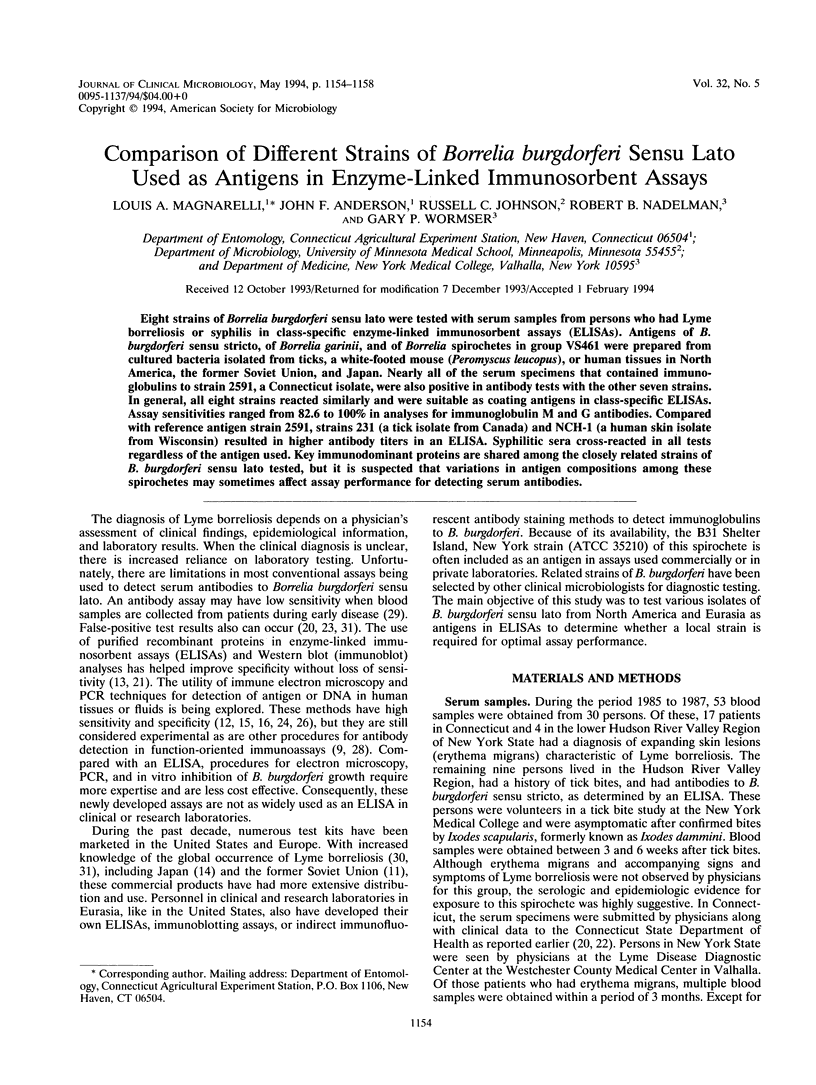
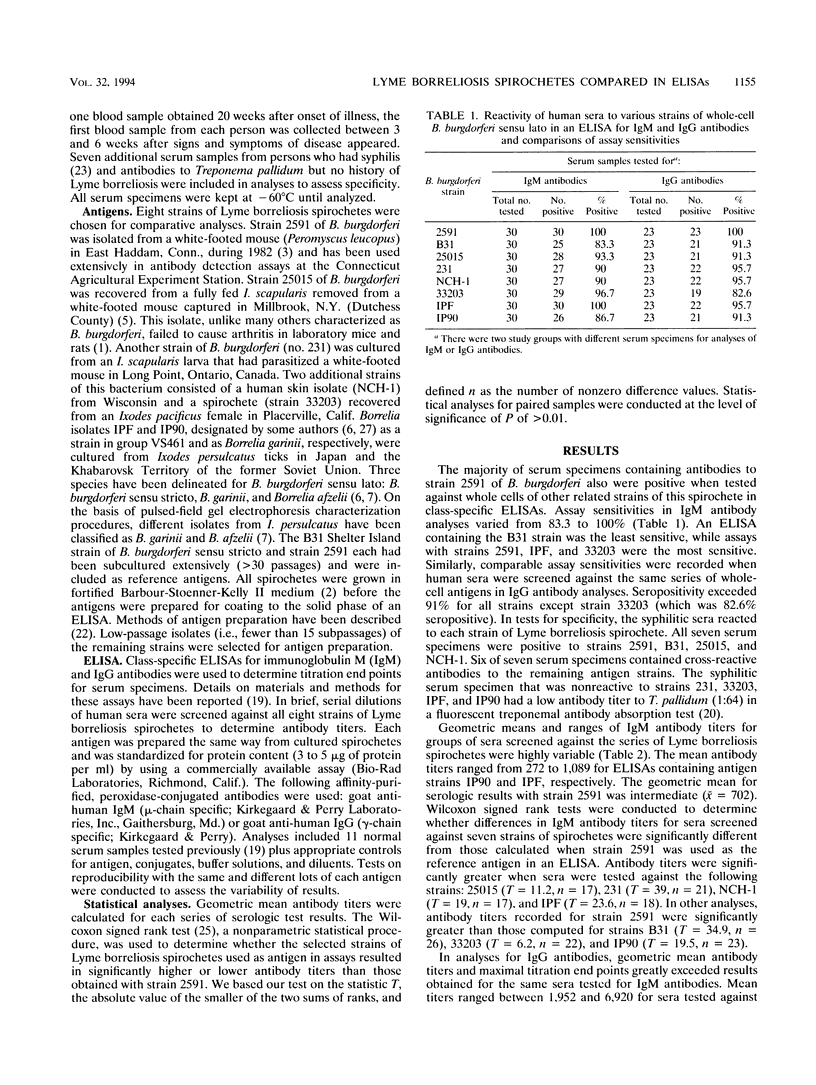
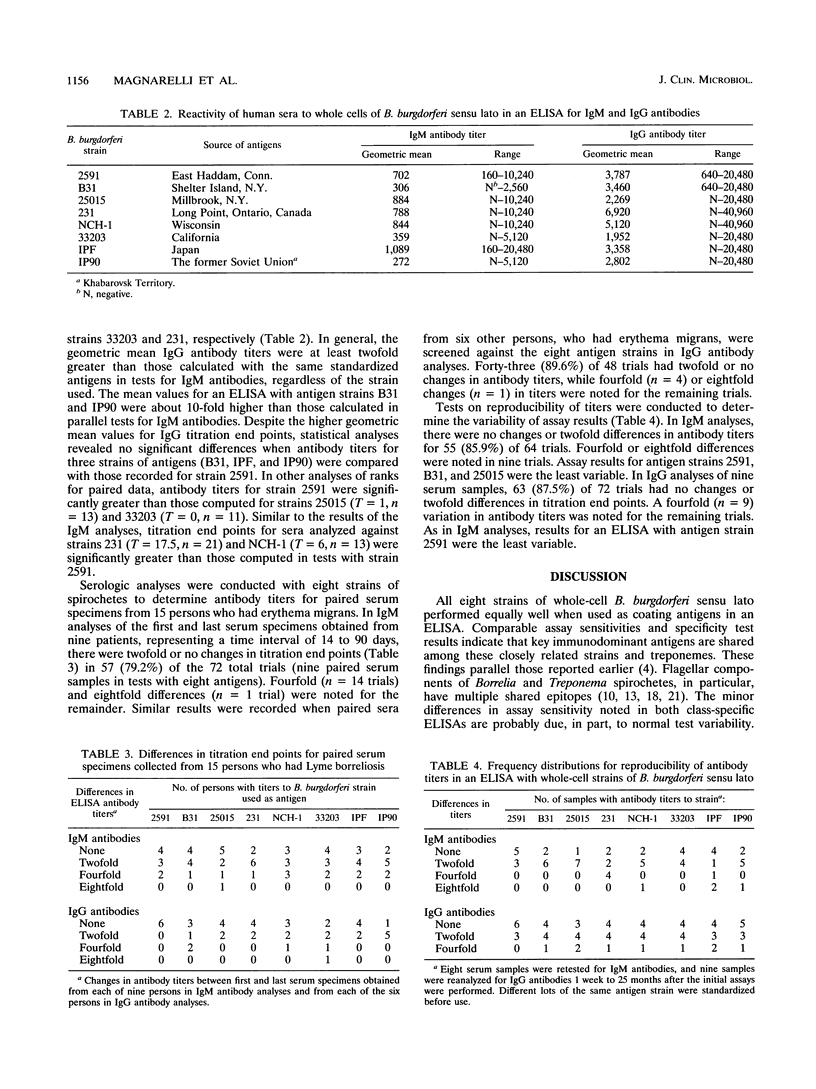
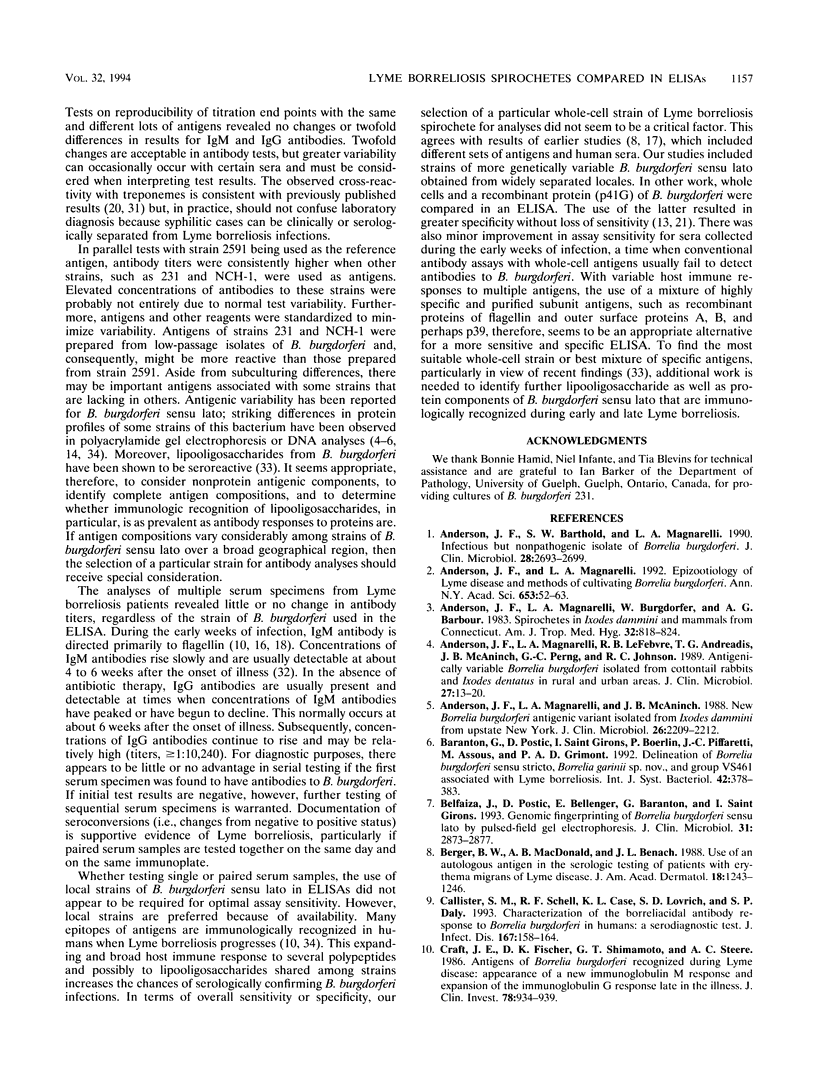
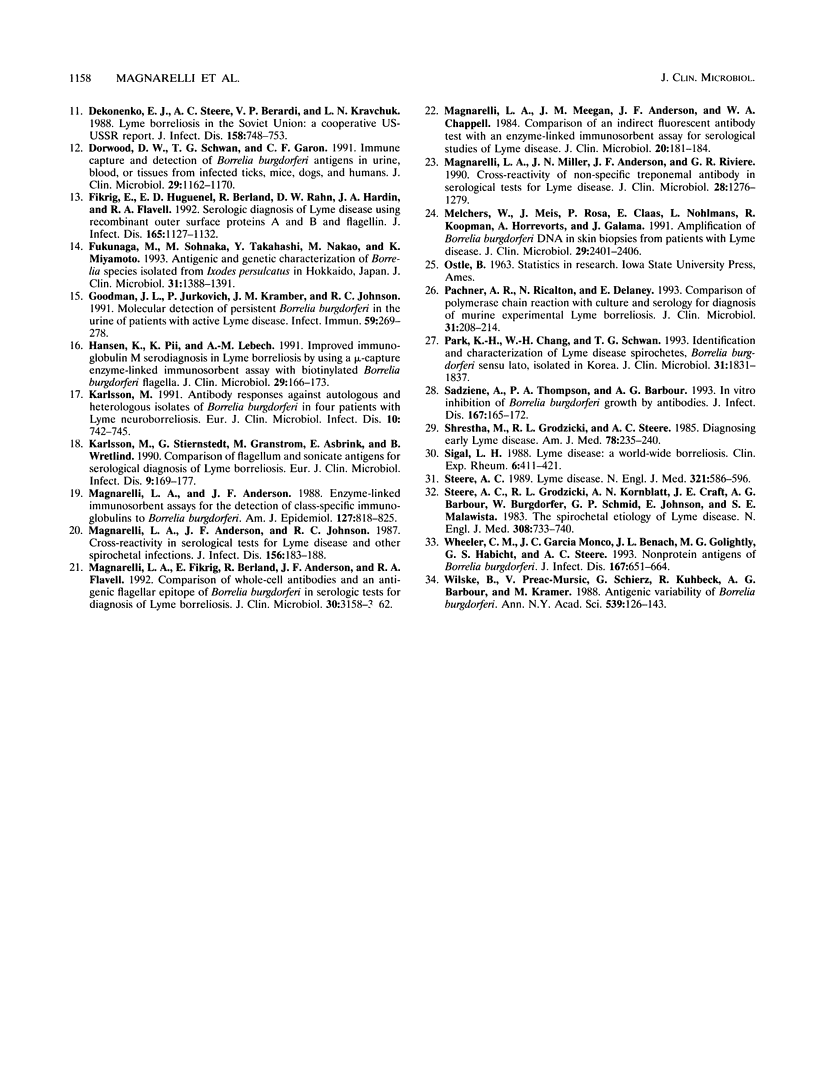
Selected References
These references are in PubMed. This may not be the complete list of references from this article.
- Anderson J. F., Barthold S. W., Magnarelli L. A. Infectious but nonpathogenic isolate of Borrelia burgdorferi. J Clin Microbiol. 1990 Dec;28(12):2693–2699. doi: 10.1128/jcm.28.12.2693-2699.1990. [DOI] [PMC free article] [PubMed] [Google Scholar]
- Anderson J. F., Magnarelli L. A., Burgdorfer W., Barbour A. G. Spirochetes in Ixodes dammini and mammals from Connecticut. Am J Trop Med Hyg. 1983 Jul;32(4):818–824. doi: 10.4269/ajtmh.1983.32.818. [DOI] [PubMed] [Google Scholar]
- Anderson J. F., Magnarelli L. A. Epizootiology of Lyme disease and methods of cultivating Borrelia burgdorferi. Ann N Y Acad Sci. 1992 Jun 16;653:52–63. doi: 10.1111/j.1749-6632.1992.tb19629.x. [DOI] [PubMed] [Google Scholar]
- Anderson J. F., Magnarelli L. A., LeFebvre R. B., Andreadis T. G., McAninch J. B., Perng G. C., Johnson R. C. Antigenically variable Borrelia burgdorferi isolated from cottontail rabbits and Ixodes dentatus in rural and urban areas. J Clin Microbiol. 1989 Jan;27(1):13–20. doi: 10.1128/jcm.27.1.13-20.1989. [DOI] [PMC free article] [PubMed] [Google Scholar]
- Anderson J. F., Magnarelli L. A., McAninch J. B. New Borrelia burgdorferi antigenic variant isolated from Ixodes dammini from upstate New York. J Clin Microbiol. 1988 Oct;26(10):2209–2212. doi: 10.1128/jcm.26.10.2209-2212.1988. [DOI] [PMC free article] [PubMed] [Google Scholar]
- Baranton G., Postic D., Saint Girons I., Boerlin P., Piffaretti J. C., Assous M., Grimont P. A. Delineation of Borrelia burgdorferi sensu stricto, Borrelia garinii sp. nov., and group VS461 associated with Lyme borreliosis. Int J Syst Bacteriol. 1992 Jul;42(3):378–383. doi: 10.1099/00207713-42-3-378. [DOI] [PubMed] [Google Scholar]
- Belfaiza J., Postic D., Bellenger E., Baranton G., Girons I. S. Genomic fingerprinting of Borrelia burgdorferi sensu lato by pulsed-field gel electrophoresis. J Clin Microbiol. 1993 Nov;31(11):2873–2877. doi: 10.1128/jcm.31.11.2873-2877.1993. [DOI] [PMC free article] [PubMed] [Google Scholar]
- Berger B. W., MacDonald A. B., Benach J. L. Use of an autologous antigen in the serologic testing of patients with erythema migrans of Lyme disease. J Am Acad Dermatol. 1988 Jun;18(6):1243–1246. doi: 10.1016/s0190-9622(88)70129-2. [DOI] [PubMed] [Google Scholar]
- Callister S. M., Schell R. F., Case K. L., Lovrich S. D., Day S. P. Characterization of the borreliacidal antibody response to Borrelia burgdorferi in humans: a serodiagnostic test. J Infect Dis. 1993 Jan;167(1):158–164. doi: 10.1093/infdis/167.1.158. [DOI] [PubMed] [Google Scholar]
- Craft J. E., Fischer D. K., Shimamoto G. T., Steere A. C. Antigens of Borrelia burgdorferi recognized during Lyme disease. Appearance of a new immunoglobulin M response and expansion of the immunoglobulin G response late in the illness. J Clin Invest. 1986 Oct;78(4):934–939. doi: 10.1172/JCI112683. [DOI] [PMC free article] [PubMed] [Google Scholar]
- Dekonenko E. J., Steere A. C., Berardi V. P., Kravchuk L. N. Lyme borreliosis in the Soviet Union: a cooperative US-USSR report. J Infect Dis. 1988 Oct;158(4):748–753. doi: 10.1093/infdis/158.4.748. [DOI] [PubMed] [Google Scholar]
- Dorward D. W., Schwan T. G., Garon C. F. Immune capture and detection of Borrelia burgdorferi antigens in urine, blood, or tissues from infected ticks, mice, dogs, and humans. J Clin Microbiol. 1991 Jun;29(6):1162–1170. doi: 10.1128/jcm.29.6.1162-1170.1991. [DOI] [PMC free article] [PubMed] [Google Scholar]
- Fikrig E., Huguenel E. D., Berland R., Rahn D. W., Hardin J. A., Flavell R. A. Serologic diagnosis of Lyme disease using recombinant outer surface proteins A and B and flagellin. J Infect Dis. 1992 Jun;165(6):1127–1132. doi: 10.1093/infdis/165.6.1127. [DOI] [PubMed] [Google Scholar]
- Fukunaga M., Sohnaka M., Takahashi Y., Nakao M., Miyamoto K. Antigenic and genetic characterization of Borrelia species isolated from Ixodes persulcatus in Hokkaido, Japan. J Clin Microbiol. 1993 May;31(5):1388–1391. doi: 10.1128/jcm.31.5.1388-1391.1993. [DOI] [PMC free article] [PubMed] [Google Scholar]
- Goodman J. L., Jurkovich P., Kramber J. M., Johnson R. C. Molecular detection of persistent Borrelia burgdorferi in the urine of patients with active Lyme disease. Infect Immun. 1991 Jan;59(1):269–278. doi: 10.1128/iai.59.1.269-278.1991. [DOI] [PMC free article] [PubMed] [Google Scholar]
- Hansen K., Pii K., Lebech A. M. Improved immunoglobulin M serodiagnosis in Lyme borreliosis by using a mu-capture enzyme-linked immunosorbent assay with biotinylated Borrelia burgdorferi flagella. J Clin Microbiol. 1991 Jan;29(1):166–173. doi: 10.1128/jcm.29.1.166-173.1991. [DOI] [PMC free article] [PubMed] [Google Scholar]
- Karlsson M. Antibody response against autologous and heterologous isolates of Borrelia burgdorferi in four patients with Lyme neuroborreliosis. Eur J Clin Microbiol Infect Dis. 1991 Sep;10(9):742–745. doi: 10.1007/BF01972499. [DOI] [PubMed] [Google Scholar]
- Karlsson M., Stiernstedt G., Granström M., Asbrink E., Wretlind B. Comparison of flagellum and sonicate antigens for serological diagnosis of Lyme borreliosis. Eur J Clin Microbiol Infect Dis. 1990 Mar;9(3):169–177. doi: 10.1007/BF01963833. [DOI] [PubMed] [Google Scholar]
- Magnarelli L. A., Anderson J. F. Enzyme-linked immunosorbent assays for the detection of class-specific immunoglobulins to Borrelia burgdorferi. Am J Epidemiol. 1988 Apr;127(4):818–825. doi: 10.1093/oxfordjournals.aje.a114864. [DOI] [PubMed] [Google Scholar]
- Magnarelli L. A., Anderson J. F., Johnson R. C. Cross-reactivity in serological tests for Lyme disease and other spirochetal infections. J Infect Dis. 1987 Jul;156(1):183–188. doi: 10.1093/infdis/156.1.183. [DOI] [PubMed] [Google Scholar]
- Magnarelli L. A., Fikrig E., Berland R., Anderson J. F., Flavell R. A. Comparison of whole-cell antibodies and an antigenic flagellar epitope of Borrelia burgdorferi in serologic tests for diagnosis of Lyme borreliosis. J Clin Microbiol. 1992 Dec;30(12):3158–3162. doi: 10.1128/jcm.30.12.3158-3162.1992. [DOI] [PMC free article] [PubMed] [Google Scholar]
- Magnarelli L. A., Meegan J. M., Anderson J. F., Chappell W. A. Comparison of an indirect fluorescent-antibody test with an enzyme-linked immunosorbent assay for serological studies of Lyme disease. J Clin Microbiol. 1984 Aug;20(2):181–184. doi: 10.1128/jcm.20.2.181-184.1984. [DOI] [PMC free article] [PubMed] [Google Scholar]
- Magnarelli L. A., Miller J. N., Anderson J. F., Riviere G. R. Cross-reactivity of nonspecific treponemal antibody in serologic tests for Lyme disease. J Clin Microbiol. 1990 Jun;28(6):1276–1279. doi: 10.1128/jcm.28.6.1276-1279.1990. [DOI] [PMC free article] [PubMed] [Google Scholar]
- Melchers W., Meis J., Rosa P., Claas E., Nohlmans L., Koopman R., Horrevorts A., Galama J. Amplification of Borrelia burgdorferi DNA in skin biopsies from patients with Lyme disease. J Clin Microbiol. 1991 Nov;29(11):2401–2406. doi: 10.1128/jcm.29.11.2401-2406.1991. [DOI] [PMC free article] [PubMed] [Google Scholar]
- Pachner A. R., Ricalton N., Delaney E. Comparison of polymerase chain reaction with culture and serology for diagnosis of murine experimental Lyme borreliosis. J Clin Microbiol. 1993 Feb;31(2):208–214. doi: 10.1128/jcm.31.2.208-214.1993. [DOI] [PMC free article] [PubMed] [Google Scholar]
- Park K. H., Chang W. H., Schwan T. G. Identification and characterization of Lyme disease spirochetes, Borrelia burgdorferi sensu lato, isolated in Korea. J Clin Microbiol. 1993 Jul;31(7):1831–1837. doi: 10.1128/jcm.31.7.1831-1837.1993. [DOI] [PMC free article] [PubMed] [Google Scholar]
- Sadziene A., Thompson P. A., Barbour A. G. In vitro inhibition of Borrelia burgdorferi growth by antibodies. J Infect Dis. 1993 Jan;167(1):165–172. doi: 10.1093/infdis/167.1.165. [DOI] [PubMed] [Google Scholar]
- Shrestha M., Grodzicki R. L., Steere A. C. Diagnosing early Lyme disease. Am J Med. 1985 Feb;78(2):235–240. doi: 10.1016/0002-9343(85)90432-2. [DOI] [PubMed] [Google Scholar]
- Sigal L. H. Lyme disease: a world-wide borreliosis. Clin Exp Rheumatol. 1988 Oct-Dec;6(4):411–421. [PubMed] [Google Scholar]
- Steere A. C., Grodzicki R. L., Kornblatt A. N., Craft J. E., Barbour A. G., Burgdorfer W., Schmid G. P., Johnson E., Malawista S. E. The spirochetal etiology of Lyme disease. N Engl J Med. 1983 Mar 31;308(13):733–740. doi: 10.1056/NEJM198303313081301. [DOI] [PubMed] [Google Scholar]
- Steere A. C. Lyme disease. N Engl J Med. 1989 Aug 31;321(9):586–596. doi: 10.1056/NEJM198908313210906. [DOI] [PubMed] [Google Scholar]
- Wilske B., Preac-Mursic V., Schierz G., Kühbeck R., Barbour A. G., Kramer M. Antigenic variability of Borrelia burgdorferi. Ann N Y Acad Sci. 1988;539:126–143. doi: 10.1111/j.1749-6632.1988.tb31846.x. [DOI] [PubMed] [Google Scholar]


